SLAS421B April 2004 – November 2016 MSP430F423 , MSP430F425 , MSP430F427
PRODUCTION DATA.
- 1Device Overview
- 2Revision History
- 3Device Comparison
- 4Terminal Configuration and Functions
-
5Specifications
- 5.1 Absolute Maximum Ratings
- 5.2 ESD Ratings
- 5.3 Recommended Operating Conditions
- 5.4 Supply Current Into AVCC and DVCC Excluding External Current
- 5.5 Thermal Resistance Characteristics, PM Package (LQFP64)
- 5.6 Schmitt-Trigger Inputs − Ports (P1 and P2), RST/NMI, JTAG (TCK, TMS, TDI/TCLK,TDO/TDI)
- 5.7 Inputs P1.x, P2.x, TAx
- 5.8 Leakage Current − Ports (P1 and P2)
- 5.9 Outputs − Ports (P1 and P2)
- 5.10 Output Frequency
- 5.11 Typical Characteristics - Ports P1 and P2
- 5.12 Wake-up Time From LPM3
- 5.13 RAM
- 5.14 LCD
- 5.15 USART0
- 5.16 POR, BOR
- 5.17 SVS (Supply Voltage Supervisor and Monitor)
- 5.18 DCO
- 5.19 Crystal Oscillator, LFXT1 Oscillator
- 5.20 SD16 Power Supply and Operating Characteristics
- 5.21 SD16 Analog Input Range
- 5.22 SD16 Analog Performance
- 5.23 SD16 Built-in Temperature Sensor
- 5.24 SD16 Built-in Voltage Reference
- 5.25 SD16 Built-in Reference Output Buffer
- 5.26 SD16 External Reference Input
- 5.27 Flash Memory
- 5.28 JTAG Interface
- 5.29 JTAG Fuse
-
6Detailed Description
- 6.1 CPU
- 6.2 Instruction Set
- 6.3 Operating Modes
- 6.4 Interrupt Vector Addresses
- 6.5 Special Function Registers
- 6.6 Memory Organization
- 6.7 Bootloader (BSL)
- 6.8 Flash Memory
- 6.9 Peripherals
- 6.10
Input/Output Diagrams
- 6.10.1 Port P1 (P1.0 and P1.1) Input/Output With Schmitt Trigger
- 6.10.2 Port P1 (P1.2 to P1.7) Input/Output With Schmitt Trigger
- 6.10.3 Port P2 (P2.0 and P2.1) Input/Output With Schmitt Trigger
- 6.10.4 Port P2 (P2.2 to P2.5) Input/Output With Schmitt Trigger
- 6.10.5 Port P2 (P2.6 and P2.7) Unbonded GPIOs
- 6.10.6 JTAG Pins TMS, TCK, TDI/TCLK, TDO/TDI, Input/Output With Schmitt-Trigger or Output
- 6.10.7 JTAG Fuse Check Mode
- 7Device and Documentation Support
- 8Mechanical, Packaging, and Orderable Information
Package Options
Mechanical Data (Package|Pins)
- PM|64
Thermal pad, mechanical data (Package|Pins)
Orderable Information
5 Specifications
5.1 Absolute Maximum Ratings(1)
over operating free-air temperature range (unless otherwise noted)| MIN | MAX | UNIT | |||
|---|---|---|---|---|---|
| Voltage applied at VCC to VSS | –0.3 | 4.1 | V | ||
| Voltage applied to any pin(2) | –0.3 | VCC + 0.3 | V | ||
| Diode current at any device terminal | ±2 | mA | |||
| Storage temperature range, Tstg | Unprogrammed device | –55 | 150 | °C | |
| Programmed device | –40 | 85 | |||
(1) Stresses beyond those listed under Absolute Maximum Ratings may cause permanent damage to the device. These are stress ratings only, and functional operation of the device at these or any other conditions beyond those indicated under Recommended Operating Conditions is not implied. Exposure to absolute-maximum-rated conditions for extended periods may affect device reliability.
(2) All voltages referenced to VSS.The JTAG fuse-blow voltage, VFB, is allowed to exceed the absolute maximum rating. The voltage is applied to the TDI/TCLK pin when blowing the JTAG fuse.
5.2 ESD Ratings
| VALUE | UNIT | |||
|---|---|---|---|---|
| V(ESD) | Electrostatic discharge | Human-body model (HBM), per ANSI/ESDA/JEDEC JS-001(1) | ±1000 | V |
| Charged-device model (CDM), per JEDEC specification JESD22-C101(2) | ±250 | |||
(1) JEDEC document JEP155 states that 500-V HBM allows safe manufacturing with a standard ESD control process. Pins listed as ±1000 V may actually have higher performance.
(2) JEDEC document JEP157 states that 250-V CDM allows safe manufacturing with a standard ESD control process. Pins listed as ±250 V may actually have higher performance.
5.3 Recommended Operating Conditions
Typical values are specified at VCC = 3.3 V and TA = 25°C (unless otherwise noted)| MIN | NOM | MAX | UNIT | ||||
|---|---|---|---|---|---|---|---|
| VCC | Supply voltage during program execution(1) (AVCC = DVCC = VCC) | SD16 disabled | 1.8 | 3.6 | V | ||
| SVS enabled, PORON = 1(2), SD16 disabled | 2.0 | 3.6 | |||||
| SD16 enabled or during programming of flash memory | 2.7 | 3.6 | |||||
| VSS | Supply voltage (AVSS = DVSS = VSS) | 0 | 0 | V | |||
| TA | Operating free-air temperature range | –40 | 85 | °C | |||
| f(LFXT1) | LFXT1 crystal frequency(3) | LF selected, XTS_FLL = 0 | Watch crystal | 32.768 | kHz | ||
| XT1 selected, XTS_FLL = 1 | Ceramic resonator | 450 | 8000 | ||||
| XT1 selected, XTS_FLL = 1 | Crystal | 1000 | 8000 | ||||
| f(System) | Processor frequency (signal MCLK) (also see Figure 5-1) | VCC = 1.8 V | DC | 4.15 | MHz | ||
| VCC = 3.6 V | DC | 8 | |||||
(1) TI recommends powering AVCC and DVCC from the same source. A maximum difference of 0.3 V between AVCC and DVCC can be tolerated during power up and operation.
(2) The minimum operating supply voltage is defined according to the trip point where POR is going active by decreasing the supply voltage. POR is going inactive when the supply voltage is raised above the minimum supply voltage plus the hysteresis of the SVS circuitry.
(3) In LF mode, the LFXT1 oscillator requires a watch crystal.
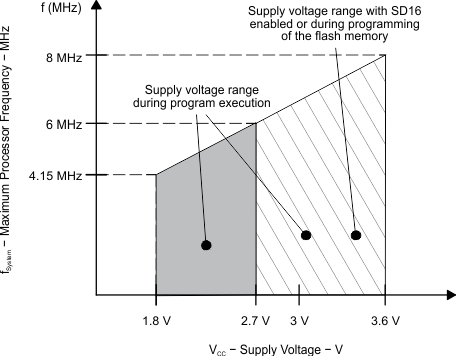 Figure 5-1 Frequency vs Supply Voltage
Figure 5-1 Frequency vs Supply Voltage
5.4 Supply Current Into AVCC and DVCC Excluding External Current(1)
over recommended operating free-air temperature range (unless otherwise noted)| PARAMETER | TA | VCC | MIN | TYP | MAX | UNIT | |
|---|---|---|---|---|---|---|---|
| I(AM) | Active mode (AM) f(MCLK) = f(SMCLK) = f(DCO) = 1 MHz, f(ACLK) = 32768 Hz, XTS_FLL = 0, program executes in flash |
–40°C to 85°C | 3 V | 400 | 500 | µA | |
| I(LPM0) | Low-power mode 0 or 1 (LPM0 or LPM1)(2)
f(MCLK) = f(SMCLK) = f(DCO) = 1 MHz, f(ACLK) = 32768 Hz, XTS_FLL = 0, FN_8 = FN_4 = FN_3 = FN_2 = 0 |
–40°C to 85°C | 3 V | 130 | 150 | µA | |
| I(LPM2) | Low-power mode 2 (LPM2)(2) | –40°C to 85°C | 3 V | 10 | 22 | µA | |
| I(LPM3) | Low-power mode 3 (LPM3) (2) | –40°C | 3 V | 1.5 | 2.0 | µA | |
| 25°C | 1.6 | 2.1 | |||||
| 60°C | 1.7 | 2.2 | |||||
| 85°C | 2.0 | 3.5 | |||||
| I(LPM4) | Low-power mode 4 (LPM4)(2) | –40°C | 3 V | 0.1 | 0.5 | µA | |
| 25°C | 0.1 | 0.5 | |||||
| 85°C | 0.8 | 2.5 | |||||
(1) All inputs are tied to 0 V or VCC. Outputs do not source or sink any current. The current consumption in LPM2, LPM3, and LPM4 are measured with active Basic Timer1 and LCD (ACLK selected). The current consumption of the SD16 and the SVS module are specified in their respective sections. LPMx currents measured with WDT+ disabled. The currents are characterized with a KDS Daishinku DT-38 (6 pF) crystal.
(2) Current consumption for brownout is included.
Current consumption of active mode versus system frequency:
I(AM) = I(AM) [at 1 MHz] × f(System) [MHz]
Current consumption of active mode versus supply voltage:
I(AM) = I(AM) [at 3 V] + 170 µA/V × (VCC – 3 V)
5.5 Thermal Resistance Characteristics, PM Package (LQFP64)
| PARAMETER | VALUE | UNIT | |
|---|---|---|---|
| RθJA | Junction-to-ambient thermal resistance, still air(1) | 55.7 | °C/W |
| RθJC(TOP) | Junction-to-case (top) thermal resistance(2) | 16.7 | °C/W |
| RθJB | Junction-to-board thermal resistance(3) | 27.1 | °C/W |
| ΨJB | Junction-to-board thermal characterization parameter | 26.8 | °C/W |
| ΨJT | Junction-to-top thermal characterization parameter | 0.8 | °C/W |
(1) The junction-to-ambient thermal resistance under natural convection is obtained in a simulation on a JEDEC-standard, High-K board, as specified in JESD51-7, in an environment described in JESD51-2a.
(2) The junction-to-case (top) thermal resistance is obtained by simulating a cold plate test on the package top. No specific JEDEC-standard test exists, but a close description can be found in the ANSI SEMI standard G30-88.
(3) The junction-to-board thermal resistance is obtained by simulating in an environment with a ring cold plate fixture to control the PCB temperature, as described in JESD51-8.
5.6 Schmitt-Trigger Inputs − Ports (P1 and P2), RST/NMI, JTAG (TCK, TMS, TDI/TCLK,TDO/TDI)
over recommended operating free-air temperature range (unless otherwise noted)| PARAMETER | VCC | MIN | MAX | UNIT | |
|---|---|---|---|---|---|
| VIT+ | Positive-going input threshold voltage | 3 V | 1.5 | 1.98 | V |
| VIT- | Negative-going input threshold voltage | 3 V | 0.9 | 1.3 | V |
| Vhys | Input voltage hysteresis (VIT+ - VIT- ) | 3 V | 0.45 | 1 | V |
5.7 Inputs P1.x, P2.x, TAx
over recommended operating free-air temperature range (unless otherwise noted)| PARAMETER | TEST CONDITIONS | VCC | MIN | MAX | UNIT | |
|---|---|---|---|---|---|---|
| t(int) | External interrupt timing | Port P1, P2: P1.x to P2.x, external trigger signal for the interrupt flag(1) | 3 V | 1.5 | cycle | |
| 50 | ns | |||||
| t(cap) | Timer_A capture timing | TAx | 3 V | 50 | ns | |
| f(TAext) | Timer_A clock frequency externally applied to pin | TAxCLK, INCLK t(H) = t(L) | 3 V | 10 | MHz | |
| f(TAint) | Timer_A clock frequency | SMCLK or ACLK signal selected | 3 V | 10 | MHz | |
(1) The external signal sets the interrupt flag every time the minimum t(int) parameters are met. It may be set even with trigger signals shorter than t(int). Both the cycle and timing specifications must be met to ensure the flag is set. t(int) is measured in MCLK cycles.
5.8 Leakage Current − Ports (P1 and P2)(1)
over recommended operating free-air temperature range (unless otherwise noted)| PARAMETER | TEST CONDITIONS | VCC | MIN | MAX | UNIT | |
|---|---|---|---|---|---|---|
| Ilkg(P1.x) | Leakage current, Port P1.x | Port 1: V(P1.x) (2) | 3 V | ±50 | nA | |
| Ilkg(P2.x) | Leakage current, Port P2.x | Port 2: V(P2.x) (2) | 3 V | ±50 | nA | |
(1) The leakage current is measured with VSS or VCC applied to the corresponding pins, unless otherwise noted.
(2) The port pin must be selected as input.
5.9 Outputs − Ports (P1 and P2)
over recommended operating free-air temperature range (unless otherwise noted)| PARAMETER | TEST CONDITIONS | VCC | MIN | MAX | UNIT | |
|---|---|---|---|---|---|---|
| VOH | High-level output voltage | IOH(max) = –1.5 mA(1) | 3 V | VCC – 0.25 | VCC | V |
| IOH(max) = –6 mA(2) | 3 V | VCC – 0.6 | VCC | |||
| VOL | Low-level output voltage | IOL(max) = 1.5 mA(1) | 3 V | VSS | VSS + 0.25 | V |
| IOL(max) = 6 mA(2) | 3 V | VSS | VSS + 0.6 | |||
(1) The maximum total current, IOH(max) and IOL(max), for all outputs combined, should not exceed ±12 mA to satisfy the maximum specified voltage drop.
(2) The maximum total current, IOH(max) and IOL(max), for all outputs combined, should not exceed ±48 mA to satisfy the maximum specified voltage drop.
5.10 Output Frequency
over recommended operating free-air temperature range (unless otherwise noted)| PARAMETER | TEST CONDITIONS | MIN | TYP | MAX | UNIT | ||
|---|---|---|---|---|---|---|---|
| f(Px.y) | Output frequency (1 ≤ × ≤ 2, 0 ≤ y ≤ 7) |
CL = 20 F, IL = ±1.5 mA, VCC = 3 V | DC | 12 | MHz | ||
| f(ACLK), | P1.1/TA0/MCLK, P1.5/TACLK/ACLK/S28 |
CL = 20 pF, VCC = 3 V | 12 | MHz | |||
| f(MCLK), | |||||||
| f(SMCLK) | |||||||
| t(Xdc) | Duty cycle of output frequency | P1.5/TACLK/ACLK/S28, CL = 20 pF, VCC = 3 V |
fACLK = fLFXT1 = fXT1 | 40% | 60% | ||
| fACLK = fLFXT1 = fLF | 30% | 70% | |||||
| fACLK = fLFXT1 | 50% | ||||||
| P1.1/TA0/MCLK, CL = 20 pF, VCC = 3 V, fMCLK = fDCOCLK |
50% – 15 ns | 50% | 50% + 15 ns | ||||
5.11 Typical Characteristics – Ports P1 and P2
Figure 5-2 through Figure 5-5 show the typical output currents of Ports P1 and P2. One output loaded at a time.
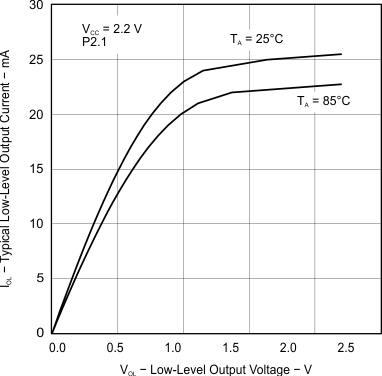 Figure 5-2 Typical Low-Level Output Current vs
Figure 5-2 Typical Low-Level Output Current vs Low-Level Output Voltage
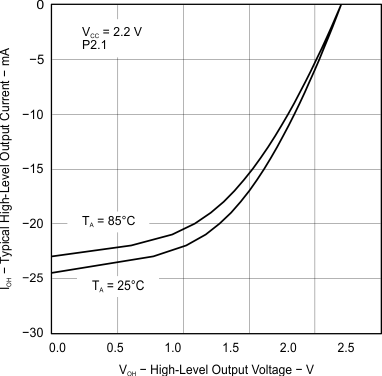 Figure 5-4 Typical High-Level Output Current vs
Figure 5-4 Typical High-Level Output Current vs High-Level Output Voltage
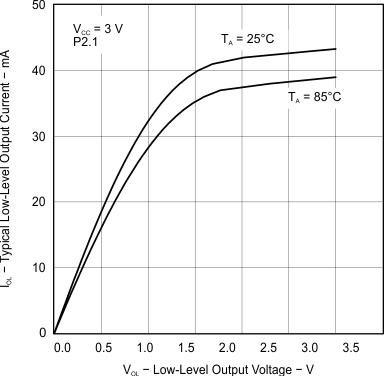 Figure 5-3 Typical Low-Level Output Current vs
Figure 5-3 Typical Low-Level Output Current vs Low-Level Output Voltage
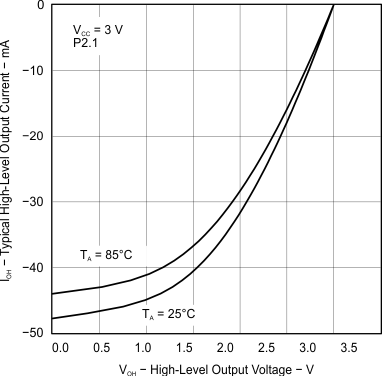 Figure 5-5 Typical High-Level Output Current vs
Figure 5-5 Typical High-Level Output Current vs High-Level Output Voltage
5.12 Wake-up Time From LPM3
over recommended operating free-air temperature range (unless otherwise noted)| PARAMETER | TEST CONDITIONS | MIN | MAX | UNIT | ||
|---|---|---|---|---|---|---|
| td(LPM3) | Delay time | f = 1 MHz | VCC = 3 V | 6 | µs | |
| f = 2 MHz | 6 | |||||
| f = 3 MHz | 6 | |||||
5.13 RAM
over recommended operating free-air temperature range (unless otherwise noted)| PARAMETER | TEST CONDITIONS | MIN | MAX | UNIT | ||
|---|---|---|---|---|---|---|
| VRAMh | CPU halted(1) | 1.6 | V | |||
(1) This parameter defines the minimum supply voltage when the data in program memory RAM remain unchanged. No program execution should take place during this supply voltage condition.
5.14 LCD
over recommended operating free-air temperature range (unless otherwise noted)| PARAMETER | TEST CONDITIONS | MIN | TYP | MAX | UNIT | ||
|---|---|---|---|---|---|---|---|
| V(33) | Analog voltage | Voltage at R33 | VCC = 3 V | 2.5 | VCC + 0.2 | V | |
| V(23) | Voltage at R23 | [V(33) – V(03)] × 2/3 + V(03) | |||||
| V(13) | Voltage at R13 | [V(33) – V(03)] × 1/3 + V(03) | |||||
| V(33) – V(03) | Voltage at R33 to R03 | 2.5 | VCC + 0.2 | ||||
| I(R03) | Input leakage | R03 = VSS | No load at all segment and common lines, VCC = 3 V |
±20 | nA | ||
| I(R13) | R13 = VCC / 3 | ±20 | |||||
| I(R23) | R23 = 2 × VCC / 3 | ±20 | |||||
| V(Sxx0) | Segment line voltage | I(Sxx) = –3 µA, VCC = 3 V | V(03) | V(03) – 0.1 | V | ||
| V(Sxx1) | V(13) | V(13) – 0.1 | |||||
| V(Sxx2) | V(23) | V(23) – 0.1 | |||||
| V(Sxx3) | V(33) | V(33) + 0.1 | |||||
5.15 USART0(1)
over recommended operating free-air temperature range (unless otherwise noted)| PARAMETER | TEST CONDITIONS | MIN | TYP | MAX | UNIT | |
|---|---|---|---|---|---|---|
| t(τ) | USART0 deglitch time | VCC = 3 V, SYNC = 0, UART mode | 150 | 280 | 500 | ns |
(1) The signal applied to the USART0 receive signal/terminal (URXD0) should meet the timing requirements of t(τ) to ensure that the URXS flip-flop is set. The URXS flip-flop is set with negative pulses meeting the minimum-timing condition of t(τ). The operating conditions to set the flag must be met independently from this timing constraint. The deglitch circuitry is active only on negative transitions on the URXD0 line.
5.16 POR, BOR(1)
over recommended operating free-air temperature range (unless otherwise noted)| PARAMETER | TEST CONDITIONS | MIN | TYP | MAX | UNIT | |
|---|---|---|---|---|---|---|
| td(BOR) | Brownout(2) | 2000 | µs | |||
| VCC(start) | dVCC/dt ≤ 3 V/s (see Figure 5-6) | 0.7 × V(B_IT– ) | V | |||
| V(B_IT–) | dVCC/dt ≤ 3 V/s (see Figure 5-6 through Figure 5-8) | 1.71 | V | |||
| Vhys(B_IT–) | dVCC/dt ≤ 3 V/s (see Figure 5-6) | 70 | 130 | 180 | mV | |
| t(reset) | Pulse duration needed at RST/NMI pin to accept reset internally, VCC = 3 V | 2 | µs | |||
(1) The current consumption of the brownout module is already included in the ICC current consumption data. The voltage level V(B_IT–) + Vhys(B_IT–) ≤ 1.8 V.
(2) During power up, the CPU begins code execution following a period of td(BOR) after VCC = V(B_IT–)+ Vhys(B_IT–). The default FLL+ settings must not be changed until VCC ≥ VCC(min), where VCC(min) is the minimum supply voltage for the desired operating frequency. See the MSP430x4xx Family User's Guide for more information on the brownout and SVS circuit.
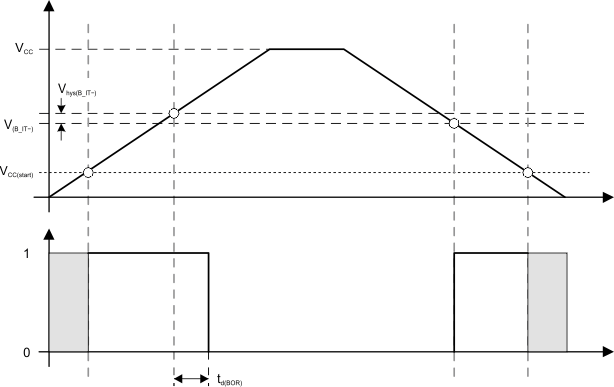 Figure 5-6 POR and BOR vs Supply Voltage
Figure 5-6 POR and BOR vs Supply Voltage
 Figure 5-7 VCC(drop) Level With a Rectangular Voltage Drop to Generate a POR or BOR Signal
Figure 5-7 VCC(drop) Level With a Rectangular Voltage Drop to Generate a POR or BOR Signal
 Figure 5-8 VCC(drop) Level With a Triangular Voltage Drop to Generate a POR or BOR Signal
Figure 5-8 VCC(drop) Level With a Triangular Voltage Drop to Generate a POR or BOR Signal
5.17 SVS (Supply Voltage Supervisor and Monitor)(3)
over recommended operating free-air temperature range (unless otherwise noted) (also see Figure 5-10)| PARAMETER | TEST CONDITIONS | MIN | TYP | MAX | UNIT | |
|---|---|---|---|---|---|---|
| t(SVSR) | dVCC/dt > 30 V/ms (see Figure 5-9) | 5 | 150 | µs | ||
| dVCC/dt ≤ 30 V/ms | 2000 | |||||
| td(SVSon) | SVS on, switch from VLD = 0 to VLD ≠ 0, VCC = 3 V | 20 | 150 | µs | ||
| tsettle | VLD ≠ 0(2) | 12 | µs | |||
| V(SVSstart) | VLD ≠ 0, VCC/dt ≤ 3 V/s (see Figure 5-9) | 1.55 | 1.7 | V | ||
| Vhys(SVS_IT–) | VCC/dt ≤ 3 V/s (see Figure 5-9) | VLD = 1 | 70 | 120 | 155 | mV |
| VLD = 2 to 14 | V(SVS_IT–) × 0.004 | V(SVS_IT–) × 0.008 | ||||
| VCC/dt ≤ 3 V/s (see Figure 5-9), external voltage applied on P2.3 | VLD = 15 | 4.4 | 10.4 | mV | ||
| V(SVS_IT–) | VCC/dt ≤ 3 V/s (see Figure 5-9) | VLD = 1 | 1.8 | 1.9 | 2.05 | V |
| VLD = 2 | 1.94 | 2.1 | 2.25 | |||
| VLD = 3 | 2.05 | 2.2 | 2.37 | |||
| VLD = 4 | 2.14 | 2.3 | 2.48 | |||
| VLD = 5 | 2.24 | 2.4 | 2.6 | |||
| VLD = 6 | 2.33 | 2.5 | 2.71 | |||
| VLD = 7 | 2.46 | 2.65 | 2.86 | |||
| VLD = 8 | 2.58 | 2.8 | 3 | |||
| VLD = 9 | 2.69 | 2.9 | 3.13 | |||
| VLD = 10 | 2.83 | 3.05 | 3.29 | |||
| VLD = 11 | 2.94 | 3.2 | 3.42 | |||
| VLD = 12 | 3.11 | 3.35 | 3.61(1) | |||
| VLD = 13 | 3.24 | 3.5 | 3.76(1) | |||
| VLD = 14 | 3.43 | 3.7(1) | 3.99(1) | |||
| VCC/dt ≤ 3 V/s (see Figure 5-9), external voltage applied on P2.3 | VLD = 15 | 1.1 | 1.2 | 1.3 | ||
| ICC(SVS)(3) | VLD ≠ 0, VCC = 2.2 V or 3 V | 10 | 15 | µA | ||
(1) The recommended operating voltage range is limited to 3.6 V.
(2) tsettle is the settling time that the comparator o/p must have a stable level after VLD is switched from VLD ≠ 0 to a different VLD value between 2 and 15. The overdrive is assumed to be greater than 50 mV.
(3) The current consumption of the SVS module is not included in the ICC current consumption data.
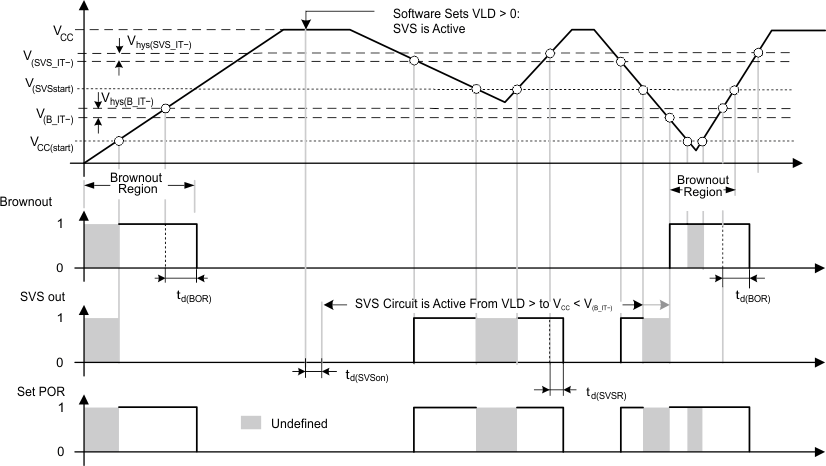 Figure 5-9 SVS Reset (SVSR) vs Supply Voltage
Figure 5-9 SVS Reset (SVSR) vs Supply Voltage
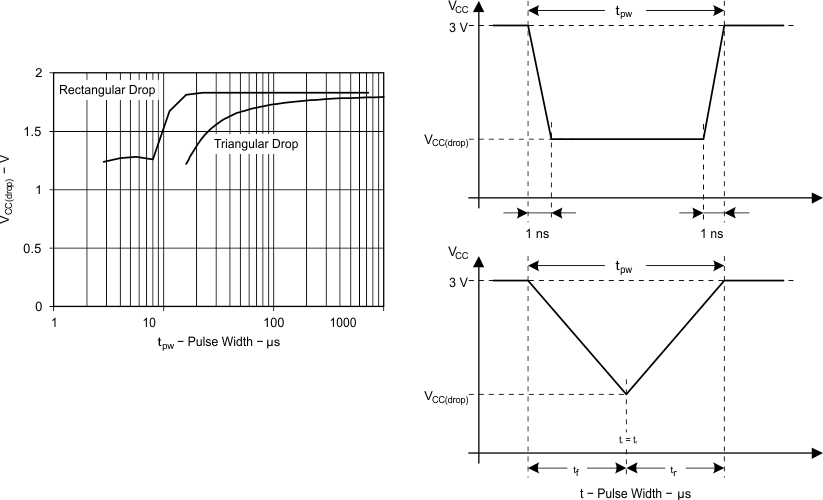 Figure 5-10 VCC(drop) With a Rectangular Voltage Drop and a Triangular Voltage Drop to Generate an SVS Signal
Figure 5-10 VCC(drop) With a Rectangular Voltage Drop and a Triangular Voltage Drop to Generate an SVS Signal
5.18 DCO
over recommended operating free-air temperature range (unless otherwise noted) (see Figure 5-11 through Figure 5-13)| PARAMETER | TEST CONDITIONS | VCC | MIN | TYP | MAX | UNIT |
|---|---|---|---|---|---|---|
| f(DCOCLK) | N(DCO) = 01Eh, FN_8 = FN_4 = FN_3 = FN_2 = 0, D = 2, DCOPLUS = 0, fCrystal = 32.768 kHz | 3 V | 1 | MHz | ||
| f(DCO = 2) | FN_8 = FN_4 = FN_3 = FN_2 = 0, DCOPLUS = 1 | 3 V | 0.3 | 0.7 | 1.3 | MHz |
| f(DCO = 27) | FN_8 = FN_4 = FN_3 = FN_2 = 0, DCOPLUS = 1 | 3 V | 2.7 | 6.1 | 11.3 | MHz |
| f(DCO = 2) | FN_8 = FN_4 = FN_3 = FN_2 = 1, DCOPLUS = 1 | 3 V | 0.8 | 1.5 | 2.5 | MHz |
| f(DCO = 27) | FN_8 = FN_4 = FN_3 = FN_2 = 1, DCOPLUS = 1 | 3 V | 6.5 | 12.1 | 20 | MHz |
| f(DCO = 2) | FN_8 = FN_4 = 0, FN_3 = 1, FN_2 = x, DCOPLUS = 1 | 3 V | 1.3 | 2.2 | 3.5 | MHz |
| f(DCO = 27) | FN_8 = FN_4 = 0, FN_3 = 1, FN_2 = x, DCOPLUS = 1 | 3 V | 10.3 | 17.9 | 28.5 | MHz |
| f(DCO = 2) | FN_8 = 0, FN_4 = 1, FN_3 = FN_2 = x, DCOPLUS = 1 | 3 V | 2.1 | 3.4 | 5.2 | MHz |
| f(DCO = 27) | FN_8 = 0, FN_4 = 1, FN_3 = FN_2 = x, DCOPLUS = 1 | 3 V | 16 | 26.6 | 41 | MHz |
| f(DCO = 2) | FN_8 = 1, FN_4 = 1 = FN_3 = FN_2 = x, DCOPLUS = 1 | 3 V | 4.2 | 6.3 | 9.2 | MHz |
| f(DCO = 27) | FN_8 = 1, FN_4 = 1 = FN_3 = FN_2 = x, DCOPLUS = 1 | 3 V | 30 | 46 | 70 | MHz |
| Sn | Step size (ratio) between adjacent DCO taps: Sn = fDCO(Tap n+1)/fDCO(Tap n) (see Figure 5-12 for taps 21 to 27) |
1 < TAP ≤ 20 | 1.06 | 1.11 | ||
| TAP = 27 | 1.07 | 1.17 | ||||
| Dt | Temperature drift, N(DCO) = 01Eh, FN_8 = FN_4 = FN_3 = FN_2 = 0, D = 2, DCOPLUS = 0 | 3 V | –0.2 | –0.3 | –0.4 | %/°C |
| DV | Drift with VCC variation, N(DCO) = 01Eh, FN_8 = FN_4 = FN_3 = FN_2 = 0, D = 2, DCOPLUS = 0 | 0 | 5 | 15 | %/V |
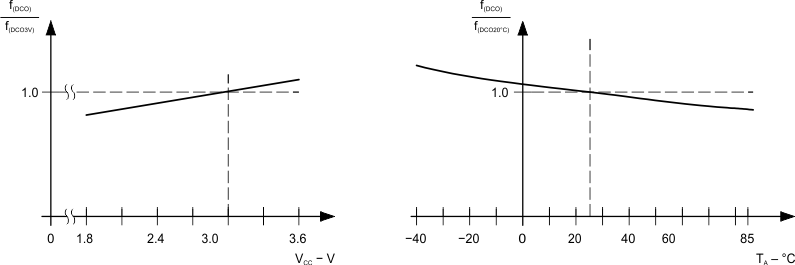 Figure 5-11 DCO Frequency vs Supply Voltage (VCC) and vs Ambient Temperature
Figure 5-11 DCO Frequency vs Supply Voltage (VCC) and vs Ambient Temperature
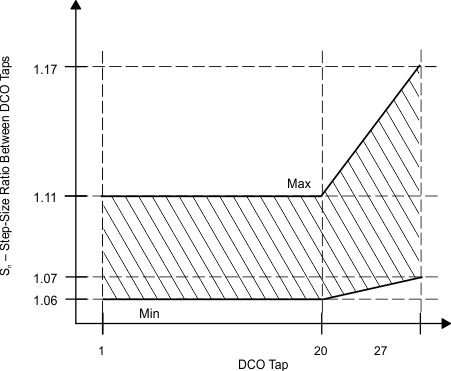 Figure 5-12 DCO Tap Step Size
Figure 5-12 DCO Tap Step Size
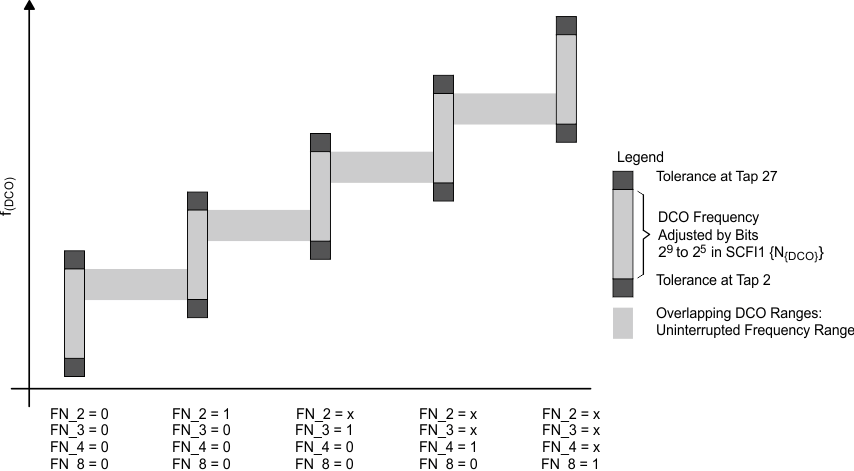 Figure 5-13 Five Overlapping DCO Ranges Controlled by FN_x Bits
Figure 5-13 Five Overlapping DCO Ranges Controlled by FN_x Bits
5.19 Crystal Oscillator, LFXT1 Oscillator(1) (2)
over recommended operating free-air temperature range (unless otherwise noted)| PARAMETER | TEST CONDITIONS | VCC | MIN | TYP | MAX | UNIT | |
|---|---|---|---|---|---|---|---|
| CXIN | Integrated input capacitance(4) | OSCCAPx = 0h | 3 V | 0 | pF | ||
| OSCCAPx = 1h | 10 | ||||||
| OSCCAPx = 2h | 14 | ||||||
| OSCCAPx = 3h | 18 | ||||||
| CXOUT | Integrated output capacitance(4) | OSCCAPx = 0h | 3 V | 0 | pF | ||
| OSCCAPx = 1h | 10 | ||||||
| OSCCAPx = 2h | 14 | ||||||
| OSCCAPx = 3h | 18 | ||||||
| VIL | Input levels at XIN(3) | 3 V | VSS | 0.2 × VCC | V | ||
| VIH | 0.8 × VCC | VCC | |||||
(1) The parasitic capacitance from the package and board may be estimated to be 2 pF. The effective load capacitor for the crystal is (CXIN × CXOUT) / (CXIN + CXOUT). This is independent of XTS_FLL.
(2) To improve EMI on the low-power LFXT1 oscillator, particularly in the LF mode (32 kHz), the following guidelines should be observed.
- Keep the trace between the device and the crystal as short as possible.
- Design a good ground plane around the oscillator pins.
- Prevent crosstalk from other clock or data lines into oscillator pins XIN and XOUT.
- Avoid running PCB traces underneath or adjacent to the XIN and XOUT pins.
- Use assembly materials and processes that avoid any parasitic load on the oscillator XIN and XOUT pins.
- If conformal coating is used, ensure that it does not induce capacitive or resistive leakage between the oscillator pins.
- Do not route the XOUT line to the JTAG header to support the serial programming adapter as shown in other documentation. This signal is no longer required for the serial programming adapter.
(3) Applies only when using an external logic-level clock source. XTS_FLL must be set. Not applicable when using a crystal or resonator.
(4) TI recommends external capacitance for precision real-time clock applications; OSCCAPx = 0h.
5.20 SD16 Power Supply and Operating Characteristics
over recommended operating free-air temperature range (unless otherwise noted)| PARAMETER | TEST CONDITIONS | VCC | MIN | TYP | MAX | UNIT | ||
|---|---|---|---|---|---|---|---|---|
| AVCC | Analog supply voltage | AVCC = DVCC, AVSS = DVSS = 0 V | 2.7 | 3.6 | V | |||
| ISD16 | Analog supply current: 1 active SD16 channel including internal reference | SD16LP = 0, fSD16 = 1 MHz, SD16OSR = 256 |
GAIN: 1, 2 | 3 V | 650 | 950 | µA | |
| GAIN: 4, 8, 16 | 730 | 1100 | ||||||
| GAIN: 32 | 1050 | 1550 | ||||||
| SD16LP = 1, fSD16 = 0.5 MHz, SD16OSR = 256 |
GAIN: 1 | 620 | 930 | |||||
| GAIN: 32 | 700 | 1060 | ||||||
| fSD16 | Analog front-end input clock frequency | SD16LP = 0 (low-power mode disabled) | 1 | MHz | ||||
| SD16LP = 1 (low-power mode enabled) | 0.5 | |||||||
5.21 SD16 Analog Input Range(1)
over operating free-air temperature range (unless otherwise noted)| PARAMETER | TEST CONDITIONS | VCC | MIN | TYP | MAX | UNIT | |
|---|---|---|---|---|---|---|---|
| VID | Differential input voltage range for specified performance(2) | SD16GAINx = 1, SD16REFON = 1 | ±500 | mV | |||
| SD16GAINx = 2, SD16REFON = 1 | ±250 | ||||||
| SD16GAINx = 4, SD16REFON = 1 | ±125 | ||||||
| SD16GAINx = 8, SD16REFON = 1 | ±62 | ||||||
| SD16GAINx = 16, SD16REFON = 1 | ±31 | ||||||
| SD16GAINx = 32, SD16REFON = 1 | ±15 | ||||||
| ZI | Input impedance (one input pin to AVSS) |
fSD16 = 1 MHz, SD16GAINx = 1 | 3 V | 200 | kΩ | ||
| fSD16 = 1 MHz, SD16GAINx = 32 | 75 | ||||||
| ZID | Differential input impedance (IN+ to IN−) |
fSD16 = 1 MHz, SD16GAINx = 1 | 3 V | 300 | 400 | kΩ | |
| fSD16 = 1 MHz, SD16GAINx = 32 | 100 | 150 | |||||
| VI | Absolute input voltage range | AVSS – 1 | AVCC | V | |||
| VIC | Common-mode input voltage range | AVSS – 1 | AVCC | V | |||
(1) All parameters pertain to each SD16 channel.
(2) The analog input range depends on the reference voltage applied to VREF. If VREF is sourced externally, the full-scale range is defined by VFSR+ = +(VREF / 2) / GAIN and VFSR− = −(VREF / 2) / GAIN. The analog input range should not exceed 80% of VFSR+ or VFSR−.
5.22 SD16 Analog Performance
fSD16 = 1 MHz, SD16OSRx = 256, SD16REFON = 1, over operating free-air temperature range (unless otherwise noted)| PARAMETER | TEST CONDITIONS | VCC | MIN | TYP | MAX | UNIT | ||
|---|---|---|---|---|---|---|---|---|
| SINAD | Signal-to-noise + distortion ratio | SD16GAINx = 1, signal amplitude = 500 mV | fIN = 50 Hz or 100 Hz | 3 V | 83.5 | 85 | dB | |
| SD16GAINx = 2, signal amplitude = 250 mV | 81.5 | 84 | ||||||
| SD16GAINx = 4, signal amplitude = 125 mV | 76 | 79.5 | ||||||
| SD16GAINx = 8, signal amplitude = 62 mV | 73 | 76.5 | ||||||
| SD16GAINx = 16, signal amplitude = 31 mV | 69 | 73 | ||||||
| SD16GAINx = 32, signal amplitude = 15 mV | 62 | 69 | ||||||
| G | Nominal gain | SD16GAINx = 1 | 3 V | 0.97 | 1.00 | 1.02 | ||
| SD16GAINx = 2 | 1.90 | 1.96 | 2.02 | |||||
| SD16GAINx = 4 | 3.76 | 3.86 | 3.96 | |||||
| SD16GAINx = 8 | 7.36 | 7.62 | 7.84 | |||||
| SD16GAINx = 16 | 14.56 | 15.04 | 15.52 | |||||
| SD16GAINx = 32 | 27.20 | 28.35 | 29.76 | |||||
| EOS | Offset error | SD16GAINx = 1 | 3 V | ±0.2 | %FSR | |||
| SD16GAINx = 32 | ±1.5 | |||||||
| dEOS/dT | Offset error temperature coefficient | SD16GAINx = 1 | 3 V | ±4 | ±20 | ppm FSR/°C | ||
| SD16GAINx = 32 | ±20 | ±100 | ||||||
| CMRR | Common-mode rejection ratio | SD16GAINx = 1, Common-mode input signal: VID = 500 mV, fIN = 50 Hz or 100 Hz |
3 V | >90 | dB | |||
| SD16GAINx = 32, Common-mode input signal: VID = 16 mV, fIN = 50 Hz or 100 Hz |
>75 | |||||||
| AC PSRR | AC power-supply rejection ratio | SD16GAINx = 1, VCC = 3 V ±100 mV, fVCC = 50 Hz | 3 V | >80 | dB | |||
| XT | Crosstalk | 3 V | <–100 | dB | ||||
5.23 SD16 Built-in Temperature Sensor(1)
over operating free-air temperature range (unless otherwise noted)| PARAMETER | TEST CONDITIONS | VCC | MIN | TYP | MAX | UNIT | |
|---|---|---|---|---|---|---|---|
| TCSensor | Sensor temperature coefficient | 1.18 | 1.32 | 1.46 | mV/K | ||
| VOffset,sensor | Sensor offset voltage | –100 | 100 | mV | |||
| VSensor | Sensor output voltage(2) | Temperature sensor voltage at TA = 85°C | 3 V | 435 | 475 | 515 | mV |
| Temperature sensor voltage at TA = 25°C | 355 | 395 | 435 | ||||
| Temperature sensor voltage at TA = 0°C | 320 | 360 | 400 | ||||
(1) The following formula can be used to calculate the temperature sensor output voltage:
VSensor,typ = TCSensor (273 + T [°C] ) + VOffset,sensor [mV]
VSensor,typ = TCSensor (273 + T [°C] ) + VOffset,sensor [mV]
(2) Results based on characterization or production test, no TCSensor or VOffset,sensor.
5.24 SD16 Built-in Voltage Reference
over operating free-air temperature range (unless otherwise noted)| PARAMETER | TEST CONDITIONS | VCC | MIN | TYP | MAX | UNIT | |
|---|---|---|---|---|---|---|---|
| VREF | Internal reference voltage | SD16REFON = 1, SD16VMIDON = 0 | 3 V | 1.14 | 1.20 | 1.26 | V |
| IREF | Reference supply current | SD16REFON = 1, SD16VMIDON = 0 | 3 V | 175 | 260 | µA | |
| TC | Temperature coefficient | SD16REFON = 1, SD16VMIDON = 0 | 3 V | 20 | 50 | ppm/K | |
| CREF | VREF load capacitance | SD16REFON = 1 SD16VMIDON = 0(1) | 100 | nF | |||
| ILOAD | VREF(I) maximum load current | SD16REFON = 0, SD16VMIDON = 0 | 3 V | ±200 | nA | ||
| tON | Turnon time | SD16REFON = 0 → 1, SD16VMIDON = 0, CREF = 100 nF |
3 V | 5 | ms | ||
| DC PSR | DC power supply rejection, ΔVREF/ΔVCC | SD16REFON = 1, SD16VMIDON = 0, VCC = 2.5 V to 3.6 V |
200 | µV/V | |||
(1) No capacitance is required on VREF. However, TI recommends a capacitance of at least 100 nF to reduce any reference voltage noise.
5.25 SD16 Built-in Reference Output Buffer
over operating free-air temperature range (unless otherwise noted)| PARAMETER | TEST CONDITIONS | VCC | MIN | TYP | MAX | UNIT | |
|---|---|---|---|---|---|---|---|
| VREF,BUF | Reference buffer output voltage | SD16REFON = 1, SD16VMIDON = 1 | 3 V | 1.2 | V | ||
| IREF,BUF | Reference supply and reference output buffer quiescent current | SD16REFON = 1, SD16VMIDON = 1 | 3 V | 385 | 600 | A | |
| CREF(O) | Required load capacitance on VREF | SD16REFON = 1, SD16VMIDON = 1 | 470 | nF | |||
| ILOAD,Max | Maximum load current on VREF | SD16REFON = 1, SD16VMIDON = 1 | 3 V | ±1 | mA | ||
| Maximum voltage variation versus load current | |ILOAD| = 0 to 1 mA | 3 V | –15 | +15 | mV | ||
| tON | Turnon time | SD16REFON = 0 → 1, SD16VMIDON = 0, CREF = 100 nF |
3 V | 100 | µs | ||
5.26 SD16 External Reference Input
over operating free-air temperature range (unless otherwise noted)| PARAMETER | TEST CONDITIONS | VCC | MIN | TYP | MAX | UNIT | |
|---|---|---|---|---|---|---|---|
| VREF(I) | Input voltage | SD16REFON = 0 | 3 V | 1.0 | 1.25 | 1.5 | V |
| IREF(I) | Input current | SD16REFON = 0 | 3 V | 50 | nA | ||
5.27 Flash Memory
over recommended operating free-air temperature range (unless otherwise noted)| PARAMETER | TEST CONDITIONS | VCC | MIN | TYP | MAX | UNIT | |
|---|---|---|---|---|---|---|---|
| VCC(PGM/ ERASE) | Program and erase supply voltage | 2.7 | 3.6 | V | |||
| fFTG | Flash timing generator frequency | 257 | 476 | kHz | |||
| IPGM | Supply current from DVCC during program | 2.7 V, 3.6 V | 3 | 5 | mA | ||
| IERASE | Supply current from DVCC during erase | 2.7 V, 3.6 V | 3 | 7 | mA | ||
| tCPT | Cumulative program time(1) | 2.7 V, 3.6 V | 10 | ms | |||
| tCMErase | Cumulative mass erase time(2) | 2.7 V, 3.6 V | 200 | ms | |||
| Program and erase endurance | 104 | 105 | cycles | ||||
| tRetention | Data retention duration | TJ = 25°C | 100 | years | |||
| tWord | Word or byte program time(3) | 35 | tFTG | ||||
| tBlock, 0 | Block program time for first byte or word(3) | 30 | |||||
| tBlock, 1–63 | Block program time for each additional byte or word(3) | 21 | |||||
| tBlock, End | Block program end-sequence wait time(3) | 6 | |||||
| tMass Erase | Mass erase time(3) | 5297 | |||||
| tSeg Erase | Segment erase time(3) | 4819 | |||||
(1) The cumulative program time must not be exceeded when writing to a 64-byte flash block. This parameter applies to all programming methods: individual word or byte write mode and block write mode.
(2) The mass erase duration generated by the flash timing generator is at least 11.1 ms ( = 5297 × (1 / fFTG,max) = 5297 × (1 / 476 kHz)). To achieve the required cumulative mass erase time, the mass erase operation of the flash controller can be repeated until this time is met (a worst case minimum of 19 cycles is required).
(3) These values are hardwired into the state machine of the flash controller (tFTG = 1 / fFTG).
5.28 JTAG Interface
over recommended operating free-air temperature range (unless otherwise noted)| PARAMETER | TEST CONDITIONS | VCC | MIN | TYP | MAX | UNIT | |
|---|---|---|---|---|---|---|---|
| fTCK | TCK input frequency | See (1) | 2.2 V | 0 | 5 | MHz | |
| 3V | 0 | 10 | |||||
| RInternal | Internal pullup resistance on TMS, TCK, TDI/TCLK | See (2) | 2.2 V, 3 V | 25 | 60 | 90 | kΩ |
(1) fTCK may be restricted to meet the timing requirements of the module selected.
(2) TMS, TDI/TCLK, and TCK pullup resistors are implemented in all versions.
5.29 JTAG Fuse(1)
over recommended operating free-air temperature range (unless otherwise noted)| PARAMETER | TEST CONDITIONS | MIN | MAX | UNIT | |
|---|---|---|---|---|---|
| VCC(FB) | Supply voltage during fuse-blow condition | TA = 25°C | 2.5 | V | |
| VFB | Voltage level on TDI/TCLK for fuse-blow | 6 | 7 | V | |
| IFB | Supply current into TDI/TCLK during fuse blow | 100 | mA | ||
| tFB | Time to blow fuse | 1 | ms | ||
(1) After the fuse is blown, no further access to the MSP430 JTAG/Test and emulation features is possible. The JTAG block is switched to bypass mode.